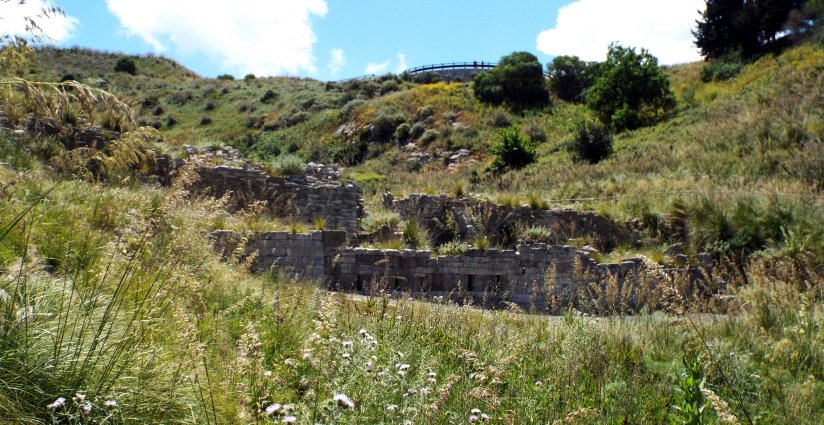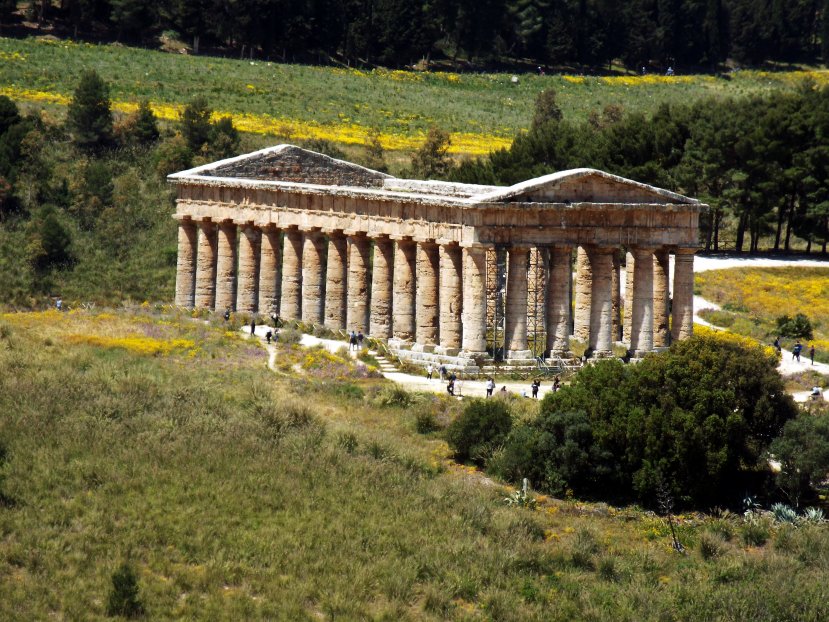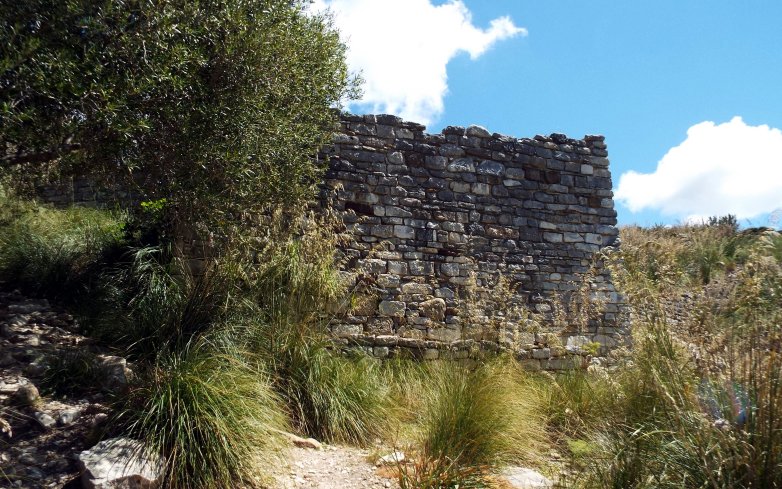Segesta

Segesta began life as an Elymian city. The
Elymians were one of the three original tribes of Sicily, their main
centres being Entella and Erice. They had their own language
using Greek letters, but this as yet is untranslated. By the
time of the Peloponnesian war (431-404 BC) the Segestans were allied
with various Greek cities in Sicily, by whom they were described as
barbarians. They were mainly at war with Syracuse and
gradually came under the protection of Carthage after being sacked in
307 BC. Just before 260BC they abandoned their allegiance to Carthage, killed the
soldiers based there and declared for Rome, being unsuccessfully
besieged, relieved by Gaius Duilius and becoming a free and immune city
under Rome. The site was destroyed by the Saracens in 900 AD,
but reused, being finally destroyed around 1240 when
the Muslim population was expelled to the mainland after a series of
revolts against Hohenstaufen rule.
Description
Four main occupation phases have been discerned at Segesta. The
first was an early fifth century BC temple of which only the
foundations survives, the second in the fourth and third centuries
consisted of a building with central yard which may have been a
gymnasium.
In the last years of the second century BC the main buildings were
constructed including the hall where the civic council met. This
had a speaker's platform in red marble from nearby Mount Inici and
seating for some 200. In front was a portico with an inscription
commemorating the director of works, Asklapos, and the architect,
Bibakos.
 The
summit of Monte Barbaro, largely protected by precipitous drops to east
and west with a boundary wall with monumental gates low down the slope
to the southwest near to the great Doric temple of 430-420 BC.
The 6'
thick rubble wall, which is pinned in the defile by 2 projecting
rectangular towers standing some 400' apart. The northeast tower
is best
preserved and is some 18' by 16'. From the site of the southwest
tower
the wall then ran southwards for some 200' to another boldly projecting
rectangular tower. The wall then runs south a further 220' before
passing under the modern road and swinging eastwards along the top of
the cliff protecting that side of the site.
The
summit of Monte Barbaro, largely protected by precipitous drops to east
and west with a boundary wall with monumental gates low down the slope
to the southwest near to the great Doric temple of 430-420 BC.
The 6'
thick rubble wall, which is pinned in the defile by 2 projecting
rectangular towers standing some 400' apart. The northeast tower
is best
preserved and is some 18' by 16'. From the site of the southwest
tower
the wall then ran southwards for some 200' to another boldly projecting
rectangular tower. The wall then runs south a further 220' before
passing under the modern road and swinging eastwards along the top of
the cliff protecting that side of the site.
 The
gate in the base of the valley was further protected by 2 towers in the
late fifth century and then around 400 BC reduced in size from 21' wide
to 10'. About 100 years later the entrance was completely blocked
and a new gate made at the Porta Stazzo, higher up at the top of the
defile in better quality rubble masonry. At this point the lower
gatehouse was converted into a military barracks. Presumably this
was due to Carthaginian or Roman activity. Finally the complex
was abandoned in the last half of the first century BC. The Porta
di Valle was then converted into an oil mill before being abandoned.
The
gate in the base of the valley was further protected by 2 towers in the
late fifth century and then around 400 BC reduced in size from 21' wide
to 10'. About 100 years later the entrance was completely blocked
and a new gate made at the Porta Stazzo, higher up at the top of the
defile in better quality rubble masonry. At this point the lower
gatehouse was converted into a military barracks. Presumably this
was due to Carthaginian or Roman activity. Finally the complex
was abandoned in the last half of the first century BC. The Porta
di Valle was then converted into an oil mill before being abandoned.
 The
upper, presumably Roman defences at the top of the valley consist of a
concave 7' thick wall blocking the pass. Again there are
rectangular towers defending the work. To the north is a
rectangular well laid rubble tower set on a fine stepped plinth.
To the south a recangular tower has been added on a short section
of westwards running wall. This is otherwise set well beyond the
main line of defence. Centrally is another projecting tower, but
this is set shortways through the wall, unlike the other towers.
The bulk of the tower is therefore within the defences, as the
lie of the land probably demands.
The
upper, presumably Roman defences at the top of the valley consist of a
concave 7' thick wall blocking the pass. Again there are
rectangular towers defending the work. To the north is a
rectangular well laid rubble tower set on a fine stepped plinth.
To the south a recangular tower has been added on a short section
of westwards running wall. This is otherwise set well beyond the
main line of defence. Centrally is another projecting tower, but
this is set shortways through the wall, unlike the other towers.
The bulk of the tower is therefore within the defences, as the
lie of the land probably demands.
During Roman domination in the last part of the second century BC the
main public buildings were built, including the bouleuterion, gymnasium
and theatre. The latter could hold some 4,000 people and was
built using fine quality monumental ashlar work. The theatre may
have been used for a thousand years before decaying and being built
upon by the new Muslim inhabitants to found a town, a mosque south of
the castle and a necropolis in the twelfth century. These were followed by a church and a castle built upon the hill top and utilising the older ruins.
Why not join me here and at other Sicilian
castles and cities? Information on this and other tours can be found at Scholarly
Sojourns.
Copyright©2019
Paul Martin Remfry


 The
summit of Monte Barbaro, largely protected by precipitous drops to east
and west with a boundary wall with monumental gates low down the slope
to the southwest near to the great Doric temple of 430-420 BC.
The 6'
thick rubble wall, which is pinned in the defile by 2 projecting
rectangular towers standing some 400' apart. The northeast tower
is best
preserved and is some 18' by 16'. From the site of the southwest
tower
the wall then ran southwards for some 200' to another boldly projecting
rectangular tower. The wall then runs south a further 220' before
passing under the modern road and swinging eastwards along the top of
the cliff protecting that side of the site.
The
summit of Monte Barbaro, largely protected by precipitous drops to east
and west with a boundary wall with monumental gates low down the slope
to the southwest near to the great Doric temple of 430-420 BC.
The 6'
thick rubble wall, which is pinned in the defile by 2 projecting
rectangular towers standing some 400' apart. The northeast tower
is best
preserved and is some 18' by 16'. From the site of the southwest
tower
the wall then ran southwards for some 200' to another boldly projecting
rectangular tower. The wall then runs south a further 220' before
passing under the modern road and swinging eastwards along the top of
the cliff protecting that side of the site. The
gate in the base of the valley was further protected by 2 towers in the
late fifth century and then around 400 BC reduced in size from 21' wide
to 10'. About 100 years later the entrance was completely blocked
and a new gate made at the Porta Stazzo, higher up at the top of the
defile in better quality rubble masonry. At this point the lower
gatehouse was converted into a military barracks. Presumably this
was due to Carthaginian or Roman activity. Finally the complex
was abandoned in the last half of the first century BC. The Porta
di Valle was then converted into an oil mill before being abandoned.
The
gate in the base of the valley was further protected by 2 towers in the
late fifth century and then around 400 BC reduced in size from 21' wide
to 10'. About 100 years later the entrance was completely blocked
and a new gate made at the Porta Stazzo, higher up at the top of the
defile in better quality rubble masonry. At this point the lower
gatehouse was converted into a military barracks. Presumably this
was due to Carthaginian or Roman activity. Finally the complex
was abandoned in the last half of the first century BC. The Porta
di Valle was then converted into an oil mill before being abandoned. The
upper, presumably Roman defences at the top of the valley consist of a
concave 7' thick wall blocking the pass. Again there are
rectangular towers defending the work. To the north is a
rectangular well laid rubble tower set on a fine stepped plinth.
To the south a recangular tower has been added on a short section
of westwards running wall. This is otherwise set well beyond the
main line of defence. Centrally is another projecting tower, but
this is set shortways through the wall, unlike the other towers.
The bulk of the tower is therefore within the defences, as the
lie of the land probably demands.
The
upper, presumably Roman defences at the top of the valley consist of a
concave 7' thick wall blocking the pass. Again there are
rectangular towers defending the work. To the north is a
rectangular well laid rubble tower set on a fine stepped plinth.
To the south a recangular tower has been added on a short section
of westwards running wall. This is otherwise set well beyond the
main line of defence. Centrally is another projecting tower, but
this is set shortways through the wall, unlike the other towers.
The bulk of the tower is therefore within the defences, as the
lie of the land probably demands.